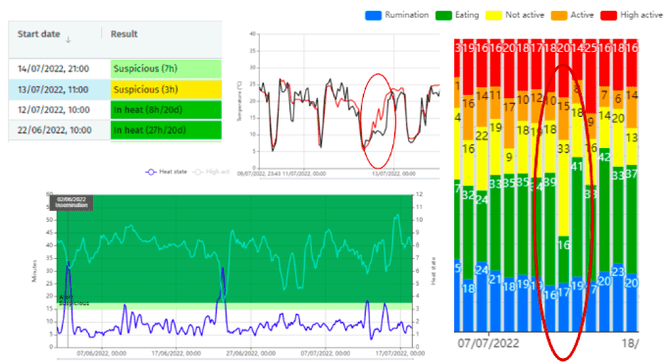Having real-time data from rumination ‘technology’ collars/tags available on farm is great. It can give us more insight into herd performance and also more information for individual cows.
This extra pair of eyes will also give you an alert if it detects a health issue with a single cow. However, this can be a little bit overwhelming when you have lots of alerts going off.
These technologies work by comparing an individual cow’s behaviour to the rest of the herd and to her own behaviour in previous hours/days. If this behaviour is ‘off” the technology will then give you an alert. These alerts are divided into health alerts and heat alerts and, depending on which technology you are using, there are also transition alerts. This article gives you a pointer on what to do with these, but because they can be a bit overwhelming, don’t hesitate to ask your KeyVet for help. We can provide flowcharts for different types of technology to give you guidance for all the alerts coming up.
Example data
To give an example of how the data looks (in this case on CowManager), you can see the data of a cow I was called out to in July below.
This was an autumn calver who had calved quite a while ago. Two days in a row she came up as “suspicious” and when she went down after milking and was showing signs of colic, the farmer called us out because he was worried that something might be twisted.
When I arrived, the cow was up again but wasn’t looking happy. She stopped kicking and on clinical examination there wasn’t any evidence of a twisted gut or twisted abomasum. However, she did show some signs of milk fever and, looking into her data, this would fit quite well as she was just coming on heat again (something we see more often).
With the right treatment, she recovered quickly. Looking into her data you can see why she was alerting. She was just coming on heat again, her temperature was lower than the group temperature and her rumination and eating time went down.
This is a good example of what a cow could look like after calving. She might not go down straight away and you might not notice her, but these early alerts are indicating that something is not going well. You might then think about using a treatment to prevent her from going down and having metabolic issues. Also, remember to double check these cows for mastitis, lameness or metricheck and follow them up to see if further actions are required!
- Femke Bluemink


